
Dominoes are a generic gaming device, similar to playing cards or dice, which can be used in a wide variety of games. The most common type of domino play is “layout games.” These are usually characterized by two main categories: blocking and scoring games. In a blocking game, players in turn place a tile on the table positioning it so that one end of the domino chain matches the number on another domino. Additional tiles are then placed on the ends of the matching domino chain, extending its length. When the chain reaches a point at which no player can proceed, the winners are the players whose combined total of all their remaining dominoes is the lowest.
Dominos may be arranged on a flat surface or in a three-dimensional structure such as a pyramid. Layouts are often made more interesting by putting the tiles on their edges and using them as a form of art. Domino artists create designs ranging from straight lines and curved lines to grids that form pictures when the dominoes fall, as well as 3D structures like towers and pyramids. The design of a domino layout is usually determined by the theme or purpose of the display.
In the early 1960s, Domino’s Pizza founder Tom Monaghan began opening franchised stores in suburban areas near college campuses. This strategy, combined with the company’s emphasis on speed of delivery, allowed Domino’s to quickly gain a reputation as a quick and inexpensive pizza option for young adults. Domino’s Pizza became the nation’s largest pizza chain by 1978 with over 200 locations.
A domino set consists of twenty-four double-sided tiles with dots or pips on both sides. Each domino has a different numerical value on each end. A domino with a single dot on one end and a five-point star on the other is called a double-six. Other pips combinations exist, and the corresponding dominoes are also known as six-pointers or six-sixes.
Each player in a domino game draws a set of tiles and places them on-edge in front of them. The players then begin placing their tiles, or “chipping,” on the table in a row. Each time a player cannot place their tile, they must draw another from their boneyard, or collection of unused tiles. In most cases, a tile must be played so that the pips on both ends match. The pips of adjacent dominoes are counted (for example, a 6-6 counts as 12).
Each player then awards points to the opponents based on the number of pips on their dominoes that match those of the opponent’s tiles. Normally, this award is based on a single round of play; however, some versions of the game allow each player to win by amassing a certain amount of points over a given number of rounds.